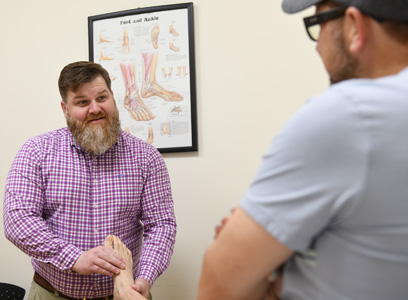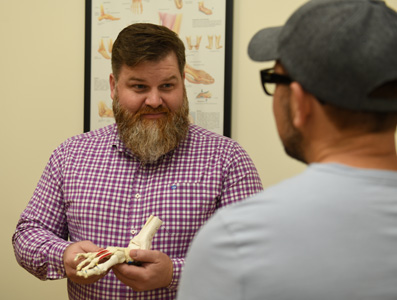Achilles Tendonitis
![]() The large tendon on the back of the heel is known as the Achilles tendon. It connects your calf muscles to your heel bone and is used when you walk, run, and jump. Tendonitis results when the tendon is overused and small tears occur in the tissue. Sufferers of Achilles tendonitis experience swelling and pain in the back of the ankle.
The large tendon on the back of the heel is known as the Achilles tendon. It connects your calf muscles to your heel bone and is used when you walk, run, and jump. Tendonitis results when the tendon is overused and small tears occur in the tissue. Sufferers of Achilles tendonitis experience swelling and pain in the back of the ankle.
Symptoms
Simply defined, tendonitis is the inflammation of a tendon. Inflammation is the body’s natural response to injury or disease, and often results in swelling, pain, or irritation.
The symptoms of acute tendonitis include:
-
Gradual onset of pain over a period of days.
-
Pain at the onset of exercise, which fades as the exercise progresses.
-
Pain eases with rest.
-
Tenderness on palpation.
Chronic Achilles tendonitis results from acute tendonitis if it goes untreated or is not allowed sufficient rest. Chronic Achilles tendonitis can be difficult to treat, particularly in older athletes.
The symptoms of chronic tendonitis include:
-
Gradual onset of pain over a period of weeks, or even months.
-
Pain with all exercise, which is constant throughout.
-
Pain in the tendon when walking, especially uphill or up stairs.
-
Pain and stiffness in the Achilles tendon, especially in the morning or after rest.
-
There may be nodules or lumps in the Achilles tendon, particularly 2-4 cm above the heel.
-
Tenderness on palpation.
-
Swelling or thickening over the Achilles tendon.
-
There may be redness on the skin.
-
You can sometimes feel a creaking when you press your fingers into the tendon and move the ankle.
Causes
Achilles tendonitis is an overuse injury. The problem results from repetitive stress to the tendon. Too much too soon is the basic cause of overuse injuries, however, there are other factors that can contribute to the development of the condition.
-
Sudden increase in the amount or intensity of exercise activity.
-
Not allowing for adequate recovery time between activities.
-
Change of footwear or training surface.
-
Weak or overly tight calf muscles.
-
Bone spurs can develop where the Achilles tendon attaches to the heel bone and rub against the tendon causing pain.
-
Running up hills causes the Achilles tendon to stretch more than normal on every stride, increasing tendon fatigue.
-
Wearing high heels constantly shortens the tendon and calf muscles. When exercising in flat running shoes, the tendon is stretched beyond its normal range, which places an ‘abnormal’ strain on the tendon.
Treatment Options
In most cases, nonsurgical treatment options will provide much needed pain relief. Although it may take a few months for symptoms to completely subside. Even with early treatment, the pain may last longer than 3 months. If you have had pain for several months before seeking treatment, it may take 6 months before treatment methods take effect.
The first step in reducing pain is to decrease or even stop the activities that make the pain worse. If you regularly do high-impact exercises, such as running, switching to low-impact activities will put less stress on the Achilles tendon. Cross-training activities such as biking, elliptical exercise, and swimming are low-impact options to help you stay active.
 Placing ice on the most painful area of the Achilles tendon is helpful and can be done as needed throughout the day. This can be done for up to 20 minutes and should be stopped earlier if the skin becomes numb. A non-steroidal anti-inflammatory medication, such as ibuprofen and pyroxene, can help reduce pain and swelling. They do not, however, reduce the thickening of the degenerated tendon.
Placing ice on the most painful area of the Achilles tendon is helpful and can be done as needed throughout the day. This can be done for up to 20 minutes and should be stopped earlier if the skin becomes numb. A non-steroidal anti-inflammatory medication, such as ibuprofen and pyroxene, can help reduce pain and swelling. They do not, however, reduce the thickening of the degenerated tendon.
Surgery should be considered to relieve Achilles tendonitis if the pain does not improve after 6 months of nonsurgical treatment. The specific type of surgery depends on the location of the tendonitis and the amount of damage to the tendon.
Recovery
Most patients have good results from surgery. The main factor in surgical recovery is the amount of damage to the tendon. The greater the amount of tendon involved, the longer the recovery period and the less likely a patient will be able to return to sports activity.
Physical therapy is an important part of recovery. Many patients require up to 12 months of rehabilitation before they are pain-free. Your Celebration Orthopaedics physical and physican therapist can customize a rehabilitation program to help you strengthen your Achilles tendon.

 Foot & Ankle
Foot & Ankle